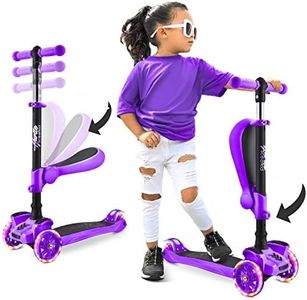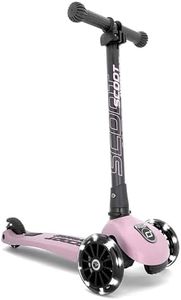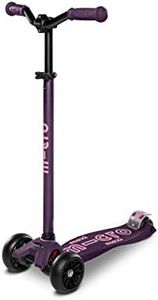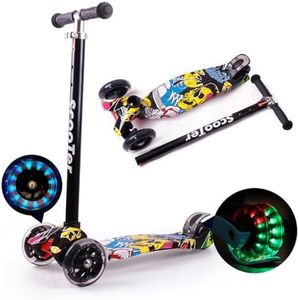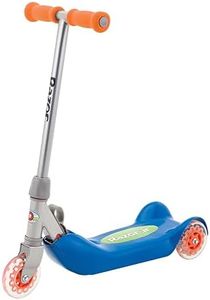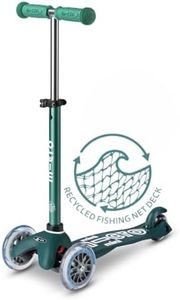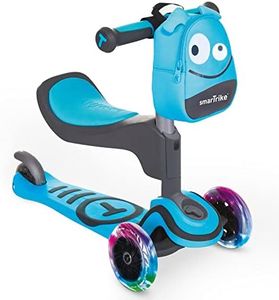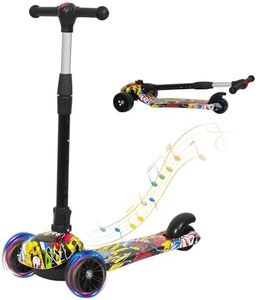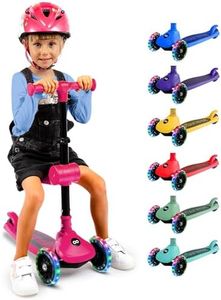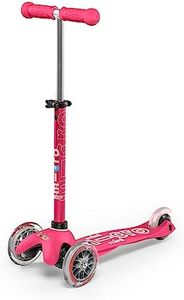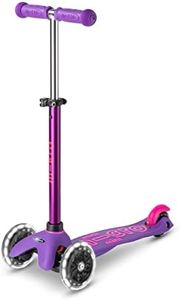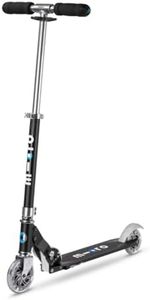We Use CookiesWe use cookies to enhance the security, performance,
functionality and for analytical and promotional activities. By continuing to browse this site you
are agreeing to our privacy policy
10 Best Toddler Scooters
From leading brands and best sellers available on the web.By clicking on a link to a third party's website, log data is shared with that third party.
Buying Guide for the Best Toddler Scooters
Choosing a toddler scooter can be exciting because it's often your child's first set of wheels! Your main priority should be finding a scooter that is safe, easy for your toddler to use, and promotes confidence as they learn to ride. Understanding the different features will help you match a scooter to your child’s age, coordination level, and how they’ll use it—whether indoors or outside in the park. Pay close attention to size, stability, and steering to make sure the scooter suits your child’s growth and skills.Number of WheelsThe number of wheels on a toddler scooter affects how stable it is. Most toddler scooters come with either three or four wheels, offering better balance and making it less likely to tip over. Two-wheeled scooters are better for older, more experienced children who have developed good balance skills. For younger ages and beginners, three or four wheels are best because they provide extra support as your child learns to scoot. Choose a higher number of wheels for toddlers just starting out, and as their confidence and balance improve, you can consider fewer wheels.
Wheel SizeWheel size determines how smoothly the scooter rolls over different surfaces and how easy it is to handle. Smaller wheels (about 100mm) are lighter and perfect for toddlers scooting indoors or on even surfaces, while slightly larger wheels can handle outdoor terrain better and offer a more comfortable ride. For the youngest riders who will mostly use the scooter on sidewalks or indoors, go for smaller wheels. If your child will be riding outside on bumpy paths, opt for slightly bigger wheels for extra comfort.
Steering MethodScooters for toddlers typically use either lean-to-steer (where you tilt the handlebar to turn) or traditional handlebar steering (where you physically turn the handlebars). Lean-to-steer is very popular for beginners because it encourages balance and is easier for little hands that might not be strong enough for turning handlebars. However, some children prefer the control of standard handlebar steering, especially if they've used ride-on toys with steering wheels before. Consider your child's age and coordination: very young or new riders may find lean-to-steer easier and safer, while slightly older or more confident toddlers might enjoy regular handlebar steering.
Handlebar Height and AdjustabilityThe height of the handlebars is important for your toddler’s safety and comfort. If the handlebars are too high or too low, your child will have trouble steering and may not feel secure. Many scooters offer adjustable handlebars, which means the scooter can grow with your child and last longer. Look for a scooter where the handlebars can be set around waist-height for your child. If you want the scooter to last more than a season, pick an adjustable handlebar that can be raised as your toddler grows.
Deck Size and MaterialThe deck is the part where your child stands. Decks that are wider and lower to the ground offer the best stability, making it easier for beginners to balance and push off. A non-slip surface is also very helpful for safety. The deck’s material should be strong and sturdy, usually plastic or metal. Wider and lower decks are best for young toddlers just getting started, while slightly narrower decks can work for older, more experienced children.
Brake TypeMost toddler scooters come with a simple rear-fender brake, which is a piece on the back wheel that your child steps on to stop. This type is easy for kids to use and understand. Some scooters don't have a brake and rely on your child stopping with their feet, which is less safe for faster riders. If your child is a cautious beginner, a rear-foot brake adds a little extra safety and is preferable, especially once they pick up speed in outdoor play.
Weight and PortabilityThe weight of the scooter matters because a lightweight scooter is easier for toddlers to handle and carry. A scooter that is too heavy for your child to manage might discourage them from using it. Portability is also a consideration if you plan on taking the scooter out to parks or on trips—some scooters can be easily folded for carrying. Choose the lightest scooter that still feels sturdy, especially for younger or smaller children, and a foldable design if you'll need to store or carry the scooter often.

